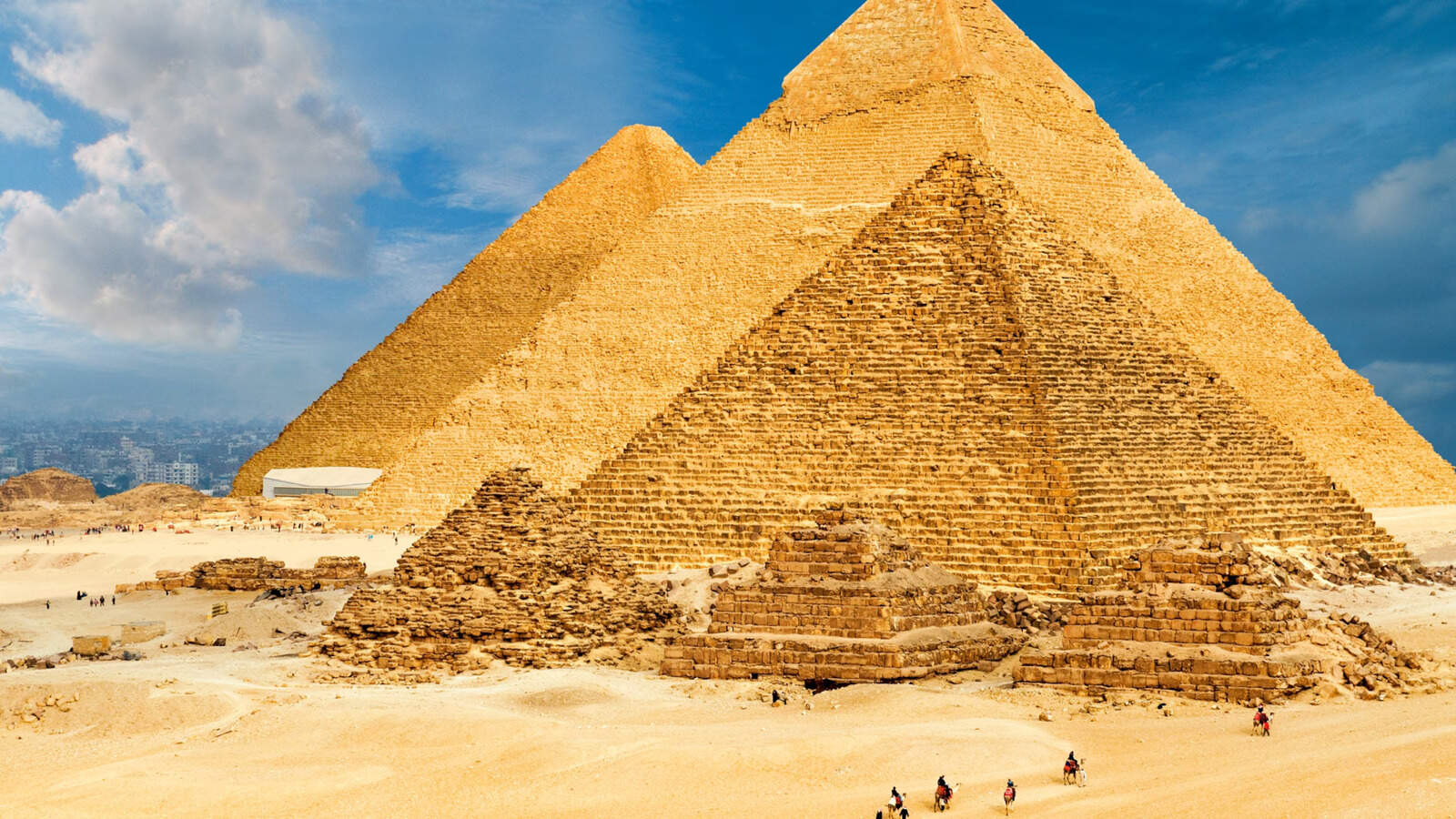
Why were the pyramids built? The pyramids, especially those in Egypt, were constructed as monumental tombs for pharaohs and their consorts. These grand structures served both as a resting place for the deceased and a means to display the ruler's power and wealth. How were the pyramids built? Ancient Egyptians used a combination of skilled labor, simple tools, and ingenious engineering techniques. Workers quarried massive limestone blocks, transported them using sledges and ramps, and meticulously placed each stone to form the pyramid's shape. What makes pyramids so fascinating? Their sheer size, precise alignment with celestial bodies, and the mysteries surrounding their construction captivate historians and tourists alike. Why do pyramids matter today? They offer invaluable insights into ancient civilizations, their beliefs, and their technological prowess.
Key Takeaways:
- The Great Pyramid of Giza, built over 4,500 years ago, remains a marvel of ancient engineering and continues to inspire awe and fascination around the world.
- The construction of the pyramids involved advanced techniques and skilled laborers, challenging popular misconceptions about their creation and purpose.
The Great Pyramid of Giza
The Great Pyramid of Giza is one of the most iconic structures in human history. It has fascinated historians, archaeologists, and tourists for centuries. Here are some intriguing facts about this ancient wonder.
- The Great Pyramid of Giza was constructed around 2580–2560 BC during the Fourth Dynasty of the Old Kingdom of Egypt.
- It was built as a tomb for the Pharaoh Khufu, also known as Cheops.
- Originally, the pyramid stood at 146.6 meters (481 feet), making it the tallest man-made structure in the world for over 3,800 years.
- The pyramid is made up of approximately 2.3 million blocks of limestone and granite, each weighing between 2.5 to 15 tons.
- The base of the pyramid covers an area of 13 acres, with each side measuring about 230.4 meters (756 feet).
- The Great Pyramid is aligned with the cardinal points of the compass—north, south, east, and west—with remarkable precision.
- The interior of the pyramid includes three main chambers: the King's Chamber, the Queen's Chamber, and the Grand Gallery.
- The pyramid was originally covered in casing stones made of highly polished Tura limestone, which reflected the sun's light and made the pyramid shine like a "gem."
The Construction Techniques
The methods used to build the pyramids have been a subject of debate and fascination. Here are some facts about the construction techniques that might surprise you.
- The ancient Egyptians used simple tools like copper chisels, wooden mallets, and stone hammers to cut and shape the massive blocks.
- Workers transported the blocks using sledges and lubricated the sand with water to reduce friction.
- Ramps were likely used to move the blocks into place, although the exact design of these ramps remains a topic of speculation.
- The workforce consisted of skilled laborers, not slaves, as previously believed. These workers lived in nearby temporary cities.
- The construction of the Great Pyramid took about 20 years to complete.
- Advanced knowledge of mathematics and astronomy was essential for the precise alignment and construction of the pyramid.
Other Famous Pyramids
While the Great Pyramid of Giza is the most famous, Egypt is home to many other remarkable pyramids. Let's explore some of them.
- The Pyramid of Djoser, also known as the Step Pyramid, was built during the Third Dynasty for Pharaoh Djoser. It is considered the earliest colossal stone building in Egypt.
- The Bent Pyramid, constructed under Pharaoh Sneferu, has a unique shape due to a change in the angle of inclination halfway up.
- The Red Pyramid, also built by Sneferu, is named for the reddish hue of its limestone blocks. It is considered the first true smooth-sided pyramid.
- The Pyramid of Menkaure, the smallest of the three pyramids at Giza, was built for Pharaoh Menkaure and stands at 65 meters (213 feet).
- The Pyramid of Khafre, also at Giza, appears taller than the Great Pyramid due to its elevated location and steeper angle.
Mysteries and Legends
The pyramids are shrouded in mystery and have inspired countless legends and theories. Here are some fascinating facts about the mysteries surrounding these ancient structures.
- Some theories suggest that the pyramids were built with the help of extraterrestrial beings, although there is no scientific evidence to support this.
- The exact purpose of the pyramids remains debated. While they are generally believed to be tombs, some theories propose they served as astronomical observatories or energy generators.
- The Sphinx, located near the pyramids of Giza, is another enigmatic structure. Its purpose and the identity of the face it bears are still subjects of speculation.
- Hidden chambers and passages within the pyramids continue to be discovered, adding to the intrigue and mystery.
- The pyramids are aligned with certain stars and constellations, suggesting a possible connection to ancient Egyptian beliefs about the afterlife and the cosmos.
Modern Discoveries and Research
Advancements in technology have allowed researchers to uncover new information about the pyramids. Here are some recent discoveries and ongoing research efforts.
- In 2017, scientists discovered a large void inside the Great Pyramid using a technique called muon tomography.
- Ground-penetrating radar and 3D scanning technologies have revealed previously unknown chambers and passages within the pyramids.
- Analysis of ancient texts and inscriptions continues to provide insights into the construction methods and purposes of the pyramids.
- DNA analysis of mummies found in pyramid tombs has helped researchers understand the lineage and health of ancient Egyptians.
- Modern engineering studies have shown that the construction techniques used by the ancient Egyptians were highly advanced and efficient.
Cultural Impact and Legacy
The pyramids have left an indelible mark on human culture and continue to inspire awe and admiration. Here are some facts about their cultural impact and legacy.
- The pyramids have been a source of inspiration for countless works of art, literature, and film.
- They are a symbol of ancient Egyptian civilization and its achievements in architecture, engineering, and mathematics.
- The pyramids attract millions of tourists each year, contributing significantly to Egypt's economy.
- They are considered one of the Seven Wonders of the Ancient World and the only one still largely intact.
- The design and construction of the pyramids have influenced modern architecture and engineering.
- The pyramids are a UNESCO World Heritage Site, recognized for their cultural and historical significance.
Fun and Lesser-Known Facts
Beyond the well-known facts, there are many fun and lesser-known tidbits about the pyramids. Here are a few to pique your interest.
- The Great Pyramid of Giza can be seen from space due to its massive size and distinctive shape.
- Some ancient graffiti found inside the pyramids suggests that workers left messages and jokes during construction.
- The pyramids have been the subject of numerous myths and legends, including tales of curses and hidden treasures.
Final Pyramid Facts
Pyramids aren't just ancient structures; they're marvels of engineering and history. Built by skilled workers, not slaves, these monuments have stood the test of time. The Great Pyramid of Giza, for example, was the tallest man-made structure for over 3,800 years. Pyramids were often aligned with celestial bodies, showcasing the Egyptians' advanced understanding of astronomy. Inside, they housed intricate passageways and chambers, designed to protect the pharaohs' treasures and mummies. Despite being thousands of years old, many pyramids still hold secrets waiting to be uncovered. Their construction techniques, involving massive limestone blocks, remain a topic of fascination and study. From their architectural brilliance to their cultural significance, pyramids continue to captivate and inspire. Next time you think of pyramids, remember they're more than just stone structures; they're a testament to human ingenuity and the mysteries of ancient civilizations.
Frequently Asked Questions
Was this page helpful?
Our commitment to delivering trustworthy and engaging content is at the heart of what we do. Each fact on our site is contributed by real users like you, bringing a wealth of diverse insights and information. To ensure the highest standards of accuracy and reliability, our dedicated editors meticulously review each submission. This process guarantees that the facts we share are not only fascinating but also credible. Trust in our commitment to quality and authenticity as you explore and learn with us.


